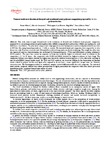Por favor, use este identificador para citar o enlazar este ítem:
http://www.alice.cnptia.embrapa.br/alice/handle/doc/1000392Registro completo de metadatos
| Campo DC | Valor | Lengua/Idioma |
|---|---|---|
| dc.contributor.author | MATTOS, B. | pt_BR |
| dc.contributor.author | LAZZAROTTO, M. | pt_BR |
| dc.contributor.author | MAGALHAES, W. L. E. | pt_BR |
| dc.contributor.author | GATTO, D. A. | pt_BR |
| dc.date.accessioned | 2014-11-18T11:11:11Z | pt_BR |
| dc.date.available | 2014-11-18T11:11:11Z | pt_BR |
| dc.date.created | 2014-11-18 | pt_BR |
| dc.date.issued | 2014 | pt_BR |
| dc.identifier.citation | In: CONGRESSO BRASILEIRO DE ANÁLISE TÉRMICA E CALORIMETRIA, 9., 2014, Serra Negra. Trabalhos. [S.l.]: ABRATEC, 2014. | pt_BR |
| dc.identifier.uri | http://www.alice.cnptia.embrapa.br/alice/handle/doc/1000392 | pt_BR |
| dc.description | This study aims to apply thermal tools in the evaluation of decayed and weathered wood polymer composites prepared by in situ polymerization of methyl methacrylate (MMA) using glycidyl methacrylate (GMA) and methacrylic acid (MAA) as cross-linkers. The pine wood samples were impregnated in a vacuum/pressure system and polymerized in an oven at 90°C for 10h, using benzoyl peroxide at 1.5 wt% as catalyst. The untreated wood and composites were exposed to in vitro decay tests with Trametes versicolor and Gloeophyllum trabeum fungi, and to artificial weathering. The weight loss after tests was measured, and the characterization was performed by thermogravimetric (TGA) and differential scanning calorimetry (DSC) analysis. The mass loss caused by exposure to fungi was evidently higher in untreated wood in relation to the composites, ~2.5 to 10 times - the composites with GMA and MAA showed the highest resistance to both fungi. The composites without cross-linkers showed the higher mass loss in the artificial weathering tests (>11%), due to the leaching of part of poly(MMA) formed inside wood. By TGA and DSC analysis, we observed shifting in the temperature of thermal events related to polysaccharides and lignin after exposed to decays tests ? more significant changes were for Trametes versicolor tests. The thermograms related to weathered samples showed different results for each composite. The untreated wood and the composite without cross-linker presented loss in lignin, meanwhile the composites with cross-linkers presented degradation in the copolymer formed onto surface of wood. Keywords: TGA, DSC, pinewood, methacrylate, additives | pt_BR |
| dc.format | Disponibilizado online. | pt_BR |
| dc.language.iso | eng | eng |
| dc.rights | openAccess | eng |
| dc.subject | Compósito | pt_BR |
| dc.subject | Polímero | pt_BR |
| dc.subject | Metacrilato | pt_BR |
| dc.subject | TGA | pt_BR |
| dc.subject | DSC | pt_BR |
| dc.subject | Pinewood | pt_BR |
| dc.subject | Methacrylate | pt_BR |
| dc.title | Thermal tools to evaluation of decayed and weathered wood polymer composites prepared by in situ polymerization. | pt_BR |
| dc.type | Artigo em anais e proceedings | pt_BR |
| dc.date.updated | 2014-11-18T11:11:11Z | pt_BR |
| dc.subject.thesagro | Aditivo | pt_BR |
| dc.subject.thesagro | Madeira | pt_BR |
| dc.subject.nalthesaurus | additives | pt_BR |
| dc.description.notes | CBRATEC. | pt_BR |
| dc.format.extent2 | 6 p. | pt_BR |
| riaa.ainfo.id | 1000392 | pt_BR |
| riaa.ainfo.lastupdate | 2014-11-18 | pt_BR |
| dc.contributor.institution | Bruno Dufau Mattos, PIPE, UFPR; MARCELO LAZZAROTTO, CNPF; WASHINGTON LUIZ ESTEVES MAGALHAES, CNPF; Darci Alberto Gatto, Universidade Federal de Pelotas. | pt_BR |
| Aparece en las colecciones: | Artigo em anais de congresso (CNPF)  | |
Ficheros en este ítem:
| Fichero | Descripción | Tamaño | Formato | |
|---|---|---|---|---|
| 2014MarceloLCBATCThermalTools.pdf | 651.66 kB | Adobe PDF |  Visualizar/Abrir |









